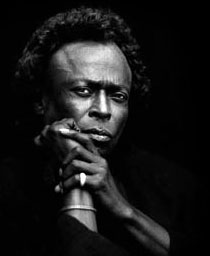June 10, 2005
Miles Davis, Isle of Wight concert, Adorno
The photo of Miles Davis is by Jeff Sedlik
 I saw the Miles Davis band at the 1970 Isle of Wight concert documentary on SBS on Tuesday night--Miles Electric: A Different Kind of Blue which had premiered at the 2004 New York Film Festival, and released on DVD by Eagle Eye Media.
I saw the Miles Davis band at the 1970 Isle of Wight concert documentary on SBS on Tuesday night--Miles Electric: A Different Kind of Blue which had premiered at the 2004 New York Film Festival, and released on DVD by Eagle Eye Media.
I hung in there through the interviews waiting for the uninterrupted 38-minute set, despite having to get up at 4.30 am the next morning to catch the early morning flight to Canberra.
That Isle of Wight concert was a music festival that has achieved an almost mythological status in rock music history. The Who appeared on the same bill as the Doors, Jimi Hendrix, Joni Mitchell and Miles Davis. This is Rolling Stone's review.--Really insightful about live music that was fresh, challenging and engaging.
The music played by Davis was very impressive. It was powerful, innnovative music that blended improvisational rock and jazz into an exciting new style. Hearing this music makes it hard to agree with Adorno that the "eunuch-like sound of the jazz band" represents the slippery slope towards the total elimination of freedom and individuality when hearing this music.
'Tis a pity the documentary did not contextualize this music more in terms of the rejection of Bitches Brew by the jazz community, or the reception of this avant garde music by the rock community. How did it compare to the powerful set by the Who or Hendrix? There was so much space in the music as there were no guitars to fill it. Though it came across as a "jazz" set, yet there were the dominant waves of bass and the drums.
The musicans in the Davis band described the music they played as transitional music--it came across as unsettled and unfinished-- but transitional to where?
The images of the music festival reminded me of the Grateful Dead famous performance in Egypt beside the pyramids, and I imagined creative avant garde music connecting up with traditional aboriginal music being played at Uluru.
If we come back to Adorno we find his hostility to Jazz being based on his understanding of jazz as basically dance or background music. It was not music that would be listened to intensely for its intellectual value.
It would appear that Adorno's main concern was with the heavily-commercialized Tin Pan Alley jazz with its standardized and repetitious forms where all spontaneity was rigorously excluded from the music.In Perennial Fashion-Jazz, Adorno writes:
"Considered as a whole, the perennial sameness of jazz consists not in a basic organization of the material within which the imagination can roam freely and without inhabitation, as within an articulate language, but rather in the utilization of certain well-defined tricks, formulas, and clichés to the exclusion of everything else."
You cannot say that the music of electric Miles is a static music whose deviations were "as standardized as the standards."
Presumably, Adorno's hostility to jazz went deeper than just the style of jazz. The presence of some advanced elements such as montage, shock, and technological production techniques, did not validate jazz for Adorno. For him, "jazz, a phantasmagoria of modernity, is illusory and provided but a "counterfeit freedom."
Posted by Gary Sauer-Thompson at June 10, 2005 12:37 PM | TrackBack